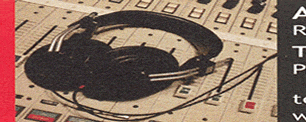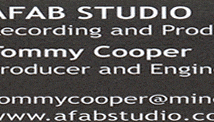|
Over the course of almost thirty years in the recording studio, I have often been asked questions having to do with how artists can get the most out of their studio experience. I am usually happy to tell them what I think and am rarely surprised when they completely disregard everything I've said because they had a better idea or someone told them they could do it cheaper by doing something else. I'm not so arrogant that I believe my advice to be fail safe and foolproof. After all, there ARE many different effective ways to go about making a good recording. But I've seen some of the same mistakes made so many times (in fact, I've made many of them myself) that I have a VERY GOOD IDEA of what NOT to do in the studio.
What follows is a list of suggestions (in no particular order) of things you can do and things you should avoid in order to get the most out of your recording experience. This is primarily aimed at the independent artist who is trying to make a quality product on a limited budget. This section will be added to from time to time and I welcome your comments and suggestions.
DO Plan your work. There is a very important stage of recording that sometimes goes overlooked called PREPRODUCTION. You should not go into the studio until you've completed this step. The studio is not the place to try to figure out what key to record a song in. You can figure that out at home. The studio is not the place to try and decide how many of a song's verses you want to include in your recording of it. You can figure that out at home, too. In fact, you can and should spend a lot more time planning your work outside the studio than you do working your plan inside the studio. You should know before entering the studio: how many songs you are going to record, which songs you are going to record, which keys you are going to record each song in, what “feel” you want to capture in each song, approximately what tempo each song should be, the “roadmap” for each song (the order of the sections ex: intro, verse 1, chorus 1, turnaround, verse 2 etc.), approximately how long each song will be and how long the entire album will be. This is all part of preproduction. If you are working with a producer (and you SHOULD be), he should be leading you through this. If you are producing your own record and need help with this, hire someone with experience to spend a few hours with you to help you with all this. One of the musicians you have hired to play your record would be a good call for this.
I am such a believer in planning that I make preproduction demos of artist's material before going to the studio. Major labels do it – why shouldn't I? These recordings are very basic: a piano or a guitar, drum machine and vocal by the artist. They don't take too long to do and they can tell you a lot. In fact, it's amazing how much you can learn in this process. To be able to listen to a song objectively without trying to sing or play at the same time is invaluable. All the subjective decisions you've made about a given song (key(s), tempo, feel, roadmap) are on display. If something's not working, you can easily fix it at this stage. I cannot overemphasize the importance of this when doing records on a limited budget. On these projects there simply isn't enough time to record a song over and over in different keys and different feels in search of what works. You need to know going in.
DO Work your plan. You should enter the studio with a plan that you intend to follow. You should know how much you expect to accomplish in the first day and each subsequent studio day. Keep your expectations realistic, though. For example, don't expect to record all your vocals in a single day. (See RECORDING VOCALS below). Allow ample time in the studio. You don't want to combine the stress of recording with the stress of a ticking clock. Some things are just going to take longer than you expected. They always do. That's normal. Accept it and plan for it.
DON'T try to include too many songs on an album. The minimum number of songs you should include is ten. In most cases, with limited budgets, the maximum number you should include is ten (unless they're all so short that your total time is under thirty minutes). The time and energy you put into any additional song(s), no matter how quick and easy it is, takes time away from those ten you MUST have and is, therefore, detracting from the quality of your album. You need all your resources to get the most out of the ten songs you HAVE to include. Who cares if artists on major labels are putting 13 or 14 or more songs on an album? They have deeper pockets to draw from. YOU CANNOT PLAY ON THE SAME PLAYING FIELD AS MAJOR LABELS. YOU JUST DON'T HAVE ENOUGH MONEY. (However, if you DO have as much money, please call me for your next recording project.)
Cheaper is not always better. Yes, we are in a bottom-line driven society. And yes, technology has made it possible for us to get more bang for our buck. And yes, much of the same equipment used in making records is affordable to the general public. And yes, hobbyists can afford to record you cheaper than a professional. But, PLEASE work with someone who is a professional in the industry – someone who does this all day every day and encounters all sorts of scenarios in the studio. Although it may seem more expensive initially, the expense will save you time and money in the long run. I've seen this so many times. An artist or someone in a group will have a friend who has some “really state-of-the-art” recording equipment at home and will record their vocals for practically nothing. So the artist/group hires the friend to record their vocals. The Friendgineer turns out to be a wonderful person who is learning (and making mistakes) as he goes. Eventually you figure out that he's a Pretendgineer. That's not what you need. Let him learn on someone else's album. The problems passed on by incompetent engineering can be expensive to deal with and almost always result in a product which is not as good as it otherwise could be. Unless you're doing an instrumental album, the vocal is the most important thing being recorded. It needs to be recorded well. NO AMOUNT OF MAGICAL MIXING CAN COMPENSATE FOR POORLY RECORDED VOCALS.
More expensive is not always better. There are good deals out there.
RECORDING RHYTHM TRACKS. Once again, planning is very important (preproduction). Rely on your producer to get you through tracking in the most efficient way possible. If you don't have a producer, you need to have a rapport with one of the musicians who is working for you. This musician needs to be your “session leader” and should be the same person who helped you through preproduction. Remember that in figuring out your expenses for the tracking day you must include payment for the musicians, the studio, the engineer, the cartage companies (companies which carry a musician's personal equipment to the studio), and the piano tuner. Have enough checks with you for everyone to be paid. Be at the studio early. Take scheduled breaks on time. And – a very personal preference based on years of observation – ALWAYS record an up-tempo song right after lunch. I have seen so many good sessions grind to a halt because a long, slow ballad was recorded as soon as the musicians returned from lunch. Right after lunch is the easiest time to lose concentration or feel drowsy. An up-tempo number kind of gets the old juices flowing again and can help prevent the after-lunch sag.
DO be flexible. As important as it is to be prepared, don't be so regimented that you miss out on some serendipity. Often in the studio a musician will hit on an idea that is really special and brings a song to a whole new level. Chances are that idea may differ significantly from what you had in mind when you were in preproduction. Don't be so committed to the original plan that you can't recognize a truly great idea and work with it. A big part of what you're paying for is the ideas that your musicians bring to the studio. And they're worth every penny.
DO be firm. Suppose someone comes up with a good idea, but it just doesn't work for you and just takes the song away from the direction you were wanting to go. Simply and politely indicate that you still prefer the original treatment and move forward. Don't let yourself be talked into something you don't really want. After all, it's YOUR record.
RECORDING VOCALS. Don't expect to record all your vocals in a single day and have them represent your best singing. Recording vocals can be a pretty grueling process sometimes and is mentally exhausting as well as hard on the vocal cords. Give yourself plenty of breaks. The time you rest will pay dividends in the final product.
WORKING WITH HEADPHONES. This is a big old can of worms. Some singers have absolutely no problem singing well in tune with headphones on. Others have a lot of trouble. There are many factors which contribute to how well a singer sings with phones on: overall loudness level, relative loudness of their vocal to the track, frequency content of the headphone mix, frequency response of the headphones, presence of chorusing, reverb and delay in the headphone mix. These and other factors effect how well a singer might perceive pitch while wearing phones. If you are having trouble singing in tune with headphones your engineer should be able to offer you several different possible solutions. Removing all reverb from the headphone mix often makes it easier for the singer to “hone in” on the pitch center. Having the singer move one phone away from an ear often helps. This allows the singer to hear himself acoustically in the room. If you are continuing to have trouble, the acid test is to go in the control room and sing along with the track while listening to the speakers. If you can sing in tune in that environment you should be able to find some combination of parameters which will allow you to sing well with headphones. If, however, you cannot sing in tune in front of speakers, you're probably never going to sing in tune with headphones, so just go back into the studio, put on the phones and do the best you can.
STACKING VOCALS. Back in the 1960's, someone figured out that if you sing along with your prerecorded vocal you can get a really nice effect. To make this work, you had to have a very good, well recorded vocal to sing to. Then you had to carefully match pitch and phrasing to create your “stack”. The effect is great, but it takes a bit of time to do it well. Some singers have a gift for being able to do this quickly. Others have a harder time with it. It has been common practice for longer than I've been doing this to stack background vocal parts. Most background vocals you hear in records today are stacked. This involves working hard to get a good first performance and then working hard to get a second one that matches and maybe even a third one. When played back together the stacked vocals sound “bigger” and “fuller” and grand and glorious.
Somehow, over the past several years many people have gotten confused about vocal stacking. They seem to think that they can record a mediocre first performance and make it sound grand and glorious by adding another performance of even poorer quality. Obviously they have never written down and read what they were doing because if they had, they would surely see how ridiculous this is. (“Hmmm...this doesn't sound too good. Oh!! I know what 'll fix it! I'll make my crummy performance sound better by adding another crummy performance on top of it!”)
Don't get me wrong. I LOVE stacking vocals. But unless you go about it with care and take a little time with it, it doesn't sound good. In fact, to my way of thinking, two lousy performances of a vocal sound TWICE as BAD, so what's the point in stacking if you're not going to do it right? You are much better served by spending a little extra time getting better performances of your primary tracks and foregoing the stacks if lack of time is a factor.
FLYING VOCALS. This is really a great way to save time in the studio. Let's say you have a song with four choruses and you want to sing harmony throughout those choruses. Take the time to go a good job singing one chorus and use that performance in the other choruses by “flying” the vocals from the first chorus to the other choruses. This works fine as long as the song doesn't change keys and the “feel” and intensity is roughly the same in all the choruses. Of course, some songs have key changes and others build in intensity from beginning to end. So there will be many instances in which you cannot “fly” vocals, but plenty where you can. To assure that this technique will work it is important to record your rhythm track with a click track to keep the tempo steady throughout the song.
TUNING VOCALS. Auto-Tuners are great! They can salvage a vocal line that felt sooooo great except it was a little out of tune. They can trim up a harmony line so that the resulting chord rings true. They provide me with a lot of income because tuning is something I do – a lot.
Auto-Tuners stink! They hoodwink singers into believing that they don't need to sing in tune, because their vocal is going to be tuned after they leave the studio anyway. They lure us all into not working quite as hard as we would if we knew we HAD to sing in tune.
I'd like to take this opportunity to remind everyone that pitch is only one aspect of a vocal performance. A lousy vocal that's been tuned is no more than a lousy vocal that's in tune. If we also had Auto-Dictionizers and Auto-Passionizers and Auto-Grooverizers we'd really be able to create a good vocal performance out of some of the crap that's been recorded. But, alas, all we have is a tuner. The moral of the story is this: strive for vocals which exhibit great passion and feel as well as pitch. Then if something's a little out of tune, it can be tuned and you have a nice performance.
By the way, there is no such thing as “auto-tune”. I have not yet found any one “set-it-and-forget-it” setting that will handle all singers in all styles. Tuners are just not smart enough to always know which note a singer is trying to sing. Generally, they correct to the nearest half-step. That means that if a singer is more than a quarter-step flat, the tuner is going to tune the vocal a half-step below the correct pitch. And if the singer has a lot of vibrato, a whole new set of problems arises with the artifacts created thereby. While you can sometimes get away with using “auto-tune” for a line or two, the only way to tune effectively is to tune a phrase at a time. It's tedious and it's time-consuming, but you can get very good results.
CHECK YOUR WORK. Sounds kind of like elementary school advice. It's important to listen carefully to your recorded performances to assure that you are satisfied with them – BEFORE you have the record mixed. I am often amazed at how closely artists and groups pay attention to every detail of their vocal after it has been mixed. I'll mix a record that has a number of imperfections in it, many of which I can fix or hide. I'll let the artists hear it and I'll get a comment such as “it sounds like the tenor singer sang the wrong words in the first line of the second verse”. Well, he did. Why are you just noticing that now? And what am I supposed to do about it at this point? The time to notice that was BEFORE you sent it to me to mix it.
|


